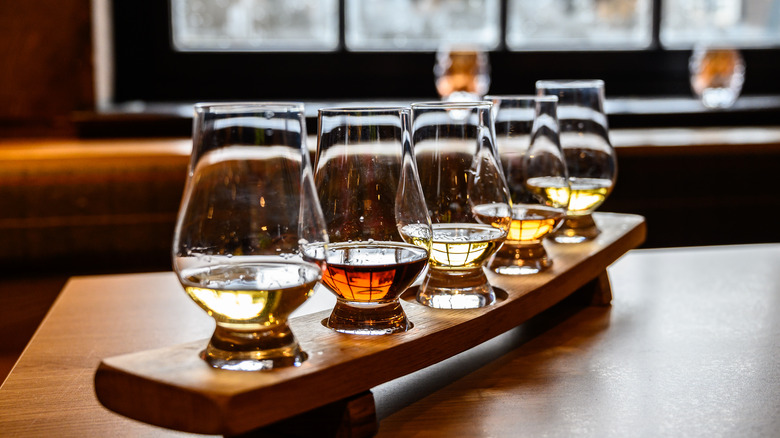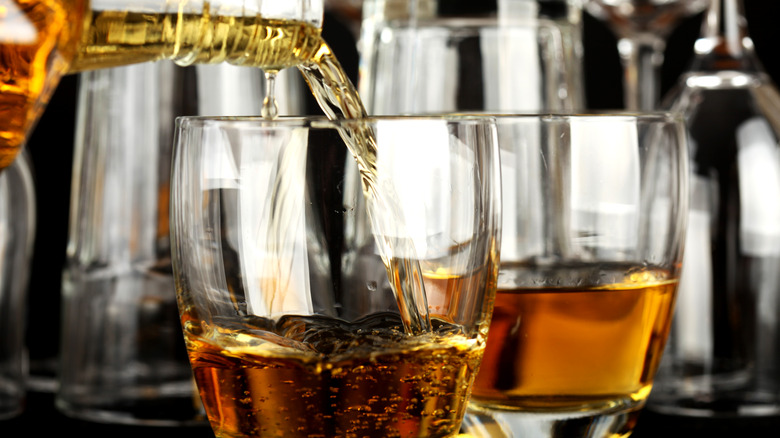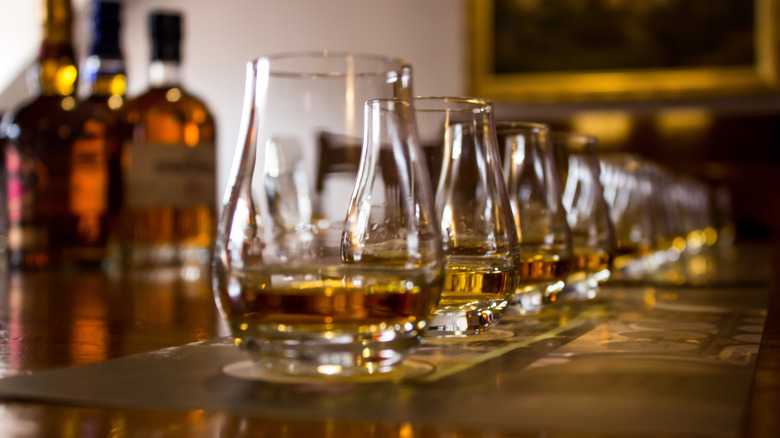A Whiskey Expert Explains Why It's Crucial To Warm Up Your Palate Before A Tasting
If you're planning on going to a whiskey tasting, then there are some tips you need to keep in mind to enjoy whiskey the right way — including warming up your palate. This essentially means getting your palate ready to taste the unique qualities of each individual whiskey, which can mean sipping on a cocktail to get your senses going or starting with a warm-up whiskey. To find out all of the details, Tasting Table spoke with an expert: Robyn Smith, the PhD founder of This Blog's NEAT and the corresponding YouTube channel.
Firstly, why is it important to warm up your palate at all? Smith explains, "Warming up your palate is crucial for stimulating your olfactory (smell) and gustatory (taste) systems, allowing you to pick out the various nuances in whiskies." Smith typically opts for a whiskey she's familiar with to warm up her palate; she then compares her tasting notes with the notes she has picked up when drinking it previously. Smith continues, "This will inform me of any biases or sensitivities I may have during the tasting."
The warm-up whiskey also works as a point of comparison for any other whiskies you will have during the tasting. Smith says the warm-up whiskey will "enhance my ability to discern subtle differences in flavor because I'm setting a baseline that I can reference throughout the tasting."
How to choose a warm-up whiskey
According to Smith, when choosing a warm-up whiskey, you should choose one that you're familiar with but also has a somewhat low ABV (alcohol by volume). Ideally, she advises that the best ABV range is between 43%-46%. Additionally, Smith looks for whiskies that have a "well-rounded flavor profile," which typically include whiskies that come from a large batch, rather than a single barrel. Finally, the warm-up whiskey should be similar to the other whiskies that you'll be tasting.
Smith says, "For example, if I'm doing a bourbon tasting, I'll pour myself a taste of Elijah Craig Small Batch, but for a Scotch tasting, I'll pour myself a taste of The Balvenie 12 year DoubleWood. Both of these whiskies act as a great baseline so that I can transition into tasting new whiskies." If reaching for a familiar whiskey isn't an option for you — maybe you don't have access to one you've tried before or maybe you're just new to whiskey in general — then there's no need to worry. In this case, you can use the first whiskey of the tasting as the warm-up whiskey. Smith continues, "You'll notice that once you get to your second whiskey, you'll be able to pick out so many more flavors."
Keep your palate as neutral as possible before a tasting
Before even choosing a warm-up whiskey, Smith emphasizes the importance of making sure that your palate is neutral for the tasting. Smith's go-to method to ensure a neutral palate is to do a whiskey tasting in the morning before eating a meal.
Smith continues, "However, if this isn't an option, try to avoid strongly flavored foods that will linger on your palate, such as meals with lots of garlic and onion, very spicy foods, or overly greasy meals." This makes sense — the last thing you want is the strong taste of garlic or something spicy lingering on your palate when you're trying to distinguish the flavor notes of each whiskey.
It may be best to save any food indulgences until after the whiskey tasting. Then, once you've picked out your favorite whiskey, you can start pairing whiskey with dried fruit or begin trying out the best bourbon-food pairings.


